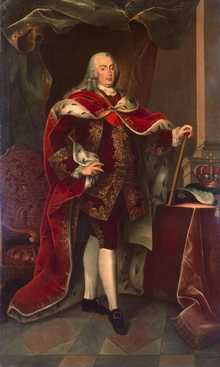
Back 1ኛ ሆሴ Amharic Chusé I de Portugal AN جوزيه الأول (ملك البرتغال) Arabic جوزيه الاول ملك الپورتوجال ARZ Xosé I de Portugal AST I Joze (Portuqaliya kralı) Azerbaijani Жазэ I Byelorussian Жозе I Bulgarian José Iañ Portugal Breton Josep I de Portugal Catalan
This article needs additional citations for verification. (December 2012) |
| Joseph I | |||||
|---|---|---|---|---|---|
 Portrait by Miguel António do Amaral, c. 1773 | |||||
| King of Portugal | |||||
| Reign | 31 July 1750 – 24 February 1777 | ||||
| Acclamation | 8 September 1750, Lisbon | ||||
| Predecessor | John V | ||||
| Successors | Maria I and Peter III | ||||
| Chief minister | Marquis of Pombal (1756–1777) | ||||
| Born | 6 June 1714 Ribeira Palace, Lisbon, Portugal | ||||
| Died | 24 February 1777 (aged 62) Sintra Palace, Sintra, Portugal | ||||
| Burial | |||||
| Spouse | |||||
| Issue | |||||
| |||||
| House | Braganza | ||||
| Father | John V of Portugal | ||||
| Mother | Maria Anna of Austria | ||||
| Religion | Roman Catholicism | ||||
| Signature |  | ||||
Dom Joseph I (Portuguese: José Francisco António Inácio Norberto Agostinho, Portuguese pronunciation: [ʒuˈzɛ]; 6 June 1714 – 24 February 1777), known as the Reformer (Portuguese: o Reformador), was King of Portugal from 31 July 1750 until his death in 1777. Among other activities, Joseph was devoted to hunting and the opera.[1] His government was controlled by Sebastião José de Carvalho e Melo, 1st Marquis of Pombal.[2]
The third child and second son of King John V, Joseph became his father's heir as an infant when his older brother, Pedro, Prince of Brazil, died.[3] In 1729 he married Infanta Mariana Victoria, the eldest daughter of Philip V of Spain.[4] Joseph and Mariana Victoria had four daughters: Maria, Mariana, Doroteia, and Benedita.
With the death of his father in 1750, Joseph became king of Portugal. His reign witnessed, among other things, a deadly earthquake in Lisbon in 1755 and a Spanish-French invasion of Portugal in 1762. The Lisbon earthquake allowed the Marquis of Pombal to consolidate power and also caused King Joseph to develop claustrophobia, refusing to live in a walled building ever again. Afterwards, Joseph moved his court into a series of tents. A new palace was built for him in Lisbon in the aftermath of the earthquake, but this was left uncompleted. Joseph died in 1777 and was succeeded by his eldest daughter, Queen Dona Maria I.
- ^ Livermore 1947, p. 354.
- ^ Livermore 1969, p. 214.
- ^ McMurdo 1889, p. 516.
- ^ Stephens 1891, p. 352.